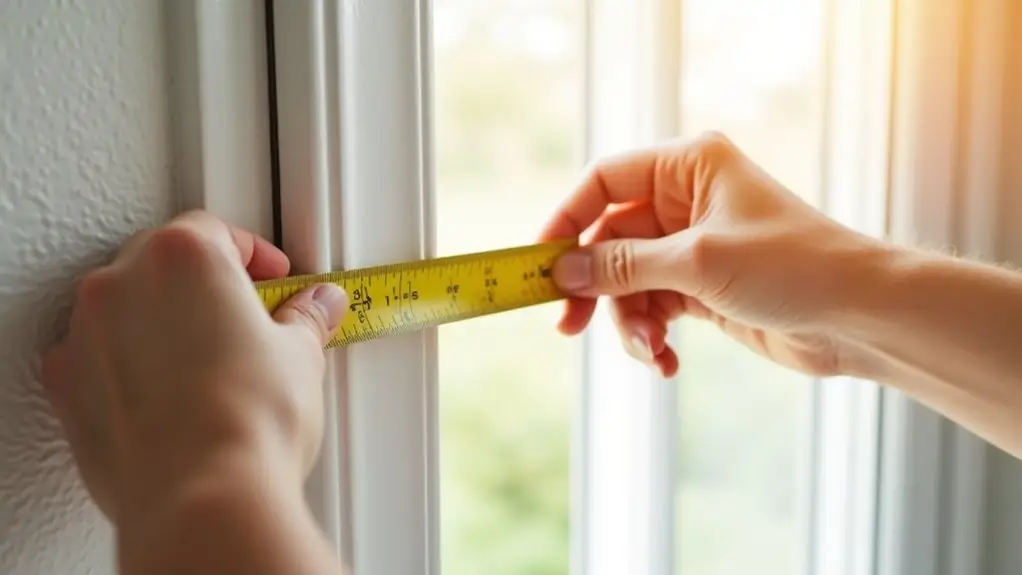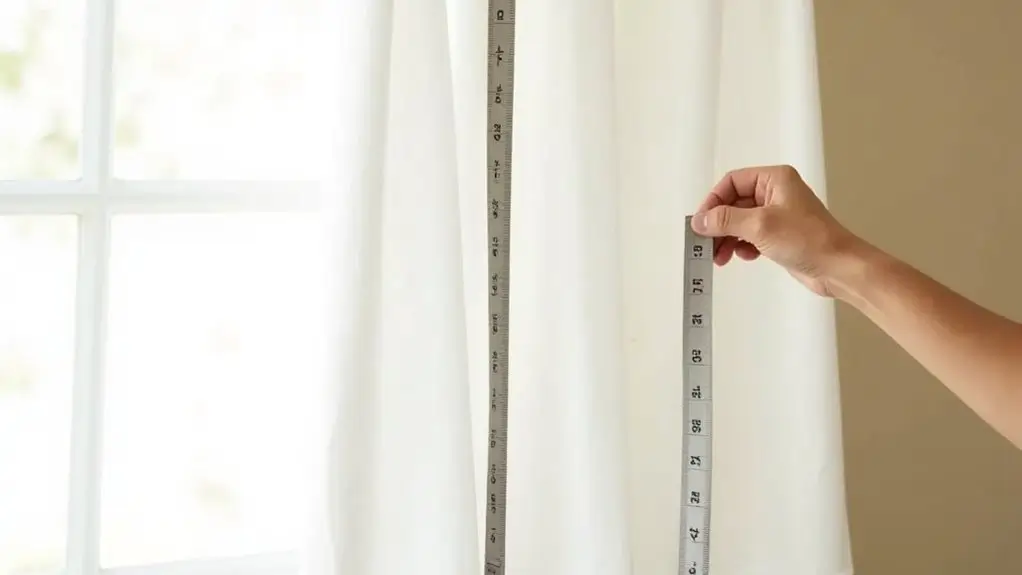If you've ever hung curtains only to find they don't quite hit the mark, you're not alone. The difference between professionally styled windows and amateur attempts often comes down to precise measurements. While it might seem straightforward to measure your windows, there's actually a subtle art to achieving that perfect drape and flow. From rod placement to fabric fullness, every inch matters in creating the polished, designer look you're after. Let's explore the essential steps to flawless window treatments.
Key Takeaways
- Measure window width at three points (top, middle, bottom) and use the widest measurement for accurate curtain sizing.
- Add 4-8 inches on each side of window frame for outside-mounted curtains to ensure proper light blocking.
- Mount curtain rods 4-6 inches above window frame and extend 3-4 inches beyond frame edges for optimal appearance.
- For floor-length curtains, measure from rod placement to floor, subtracting 1/2 inch for floating or adding 2-6 inches for pooling.
- Double width measurements when ordering curtains to achieve proper fullness and natural-looking pleats when closed.
Essential Tools and Pre-Measurement Planning

Before embarking on your curtain-measuring journey, gathering the right tools will ensure precise measurements and professional-looking results.
You'll need a metal measuring tape that's at least 25 feet long, as fabric measuring tapes can stretch and provide inaccurate readings. Keep a calculator handy for quick calculations of width and length requirements.
Create a clean measurement worksheet where you'll record all dimensions, window specifications, and design notes.
Clear the area around your windows, removing any obstacles that might interfere with accurate measurements. If you're planning layered treatments, note the space needed for mounting hardware and proper fullness.
How to Measure Curtains: Step-by-Step Curtain Measurement Techniques

To achieve perfectly fitted window treatments, you'll need to start by measuring your window's width at three points - top, middle, and bottom - using the widest measurement as your guide.
Next, determine your curtain length by measuring from where you'll mount the rod (typically 4-6 inches above the window frame) down to your desired endpoint, whether that's the windowsill, below the sill, or floor-length.
When planning rod placement, extend 8-12 inches beyond each side of your window frame to allow enough stack-back space for fully opened curtains and to maximize natural light.
Width Measurements For Windows
Getting accurate width measurements stands as the foundation for perfectly fitted window treatments. To measure the width, you'll need a steel measuring tape and these essential steps:
- Measure the window width at three points - top, middle, and bottom - using the frame's outer edges.
- For inside-mounted treatments, subtract 1/4 inch from the narrowest width measurement.
- For outside-mounted curtains, add 4-8 inches on each side for optimal light control.
- Consider stackback - the space curtains occupy when fully open.
- Double-check measurements to ensure symmetry and proper coverage.
Length From Top Down
Precise vertical measurements create the perfect length for your window treatments, dramatically influencing your room's visual appeal.
To determine curtain length, measure from the top of your planned rod placement down to your desired endpoint. For a floating look, stop 1/2 inch above the floor. If you prefer pooling drapes, add 2-6 inches beyond the floor measurement. For sill-length curtains, measure to just below the window ledge.
Consider your room's style when deciding length—café curtains typically hit the sill, while formal spaces often showcase floor-length or pooling drapes.
Don't forget to account for rings or clips in your measurements.
Calculate Curtain Rod Placement Points
While every window treatment starts with proper rod placement, determining the ideal mounting points requires careful consideration of both aesthetics and function.
For a balanced, professional look, follow these essential rod mount guidelines:
- Position your rod 4-6 inches above the window frame to create height and grandeur.
- Extend brackets 3-4 inches beyond each side of the window frame.
- Center the rod precisely over the window to ensure symmetrical draping.
- Account for crown molding or other architectural features that might affect placement.
- Mark mounting points with a pencil and level before drilling to guarantee perfect alignment.
Your rod placement sets the foundation for how your curtains will frame and enhance your window's overall appearance.
Common Measuring Mistakes and How to Avoid Them

When measuring for curtains, you'll want to avoid three critical mistakes that can derail your window treatment project.
First, calculate your rod width by extending 8-12 inches beyond each window frame edge, rather than measuring just the window width, to achieve proper fullness and light control.
Don't forget to account for rod drop height from the ceiling and window depth clearance, as these measurements ensure your curtains will hang beautifully without catching on windowsills or radiators.
Wrong Rod Width Calculations
Making mistakes with rod width calculations can completely undermine your window treatment design, no matter how beautiful your chosen fabric may be.
To achieve the perfect draping effect and maximize your window's visual impact, you'll need precise rod length measurements.
- Measure your window width from edge to edge, then add 8-12 inches for proper stack-back
- Account for finials and mounting brackets in your total rod length calculation
- Consider double-width requirements for fuller gathering and pleating
- Allow extra width for curtains to fully clear the window when open
- Ensure symmetrical rod extension on both sides of the window frame
Skipping Rod Drop Height
Beyond precise rod width measurements, the height at which you mount your curtain rod dramatically affects your room's visual proportions.
Don't make the common mistake of measuring from the window frame alone - your curtains should start higher to create an illusion of taller windows and increased ceiling height.
To determine ideal rod placement, measure from the floor to where the top of the rod will sit.
For standard 8-foot ceilings, mount the rod 4-6 inches above the window frame.
In rooms with higher ceilings, you can extend this to 8-12 inches for a more dramatic effect, making your space feel grander and more sophisticated.
Ignoring Window Depth Clearance
Another crucial measurement that many homeowners overlook is the window depth clearance - the space between your window frame and the curtain rod.
To ensure your curtains hang beautifully and function properly, consider these essential depth clearance factors:
- Allow at least 3 inches between the rod and window frame for light filtering.
- Account for window cranks or handles that might interfere with fabric flow.
- Consider radiators or air vents that could affect curtain movement.
- Factor in window screens or storm windows when measuring depth.
- Leave extra space if you're planning to layer curtains or add blackout liners.
Proper depth clearance prevents fabric bunching and ensures smooth operation of your window treatments.
Frequently Asked Questions
Can I Use the Same Curtains for Different-Sized Windows?
You'll want to avoid using identical curtains on different-sized windows, as it'll create visual imbalance. Instead, choose coordinating fabrics in proportional lengths to maintain your room's aesthetic harmony and design flow.
How Often Should I Replace My Curtains to Maintain Their Appearance?
You'll want to replace your curtains every 5-7 years, though well-maintained panels can last longer. Watch for fading, sun damage, or fabric deterioration, and rotate them periodically to ensure even wear and lasting beauty.
What's the Best Fabric Choice for Blackout Curtains in Bedrooms?
You'll achieve optimal light blocking with triple-weave polyester or velvet blackout curtains. These luxurious fabrics create a sophisticated bedroom sanctuary while effectively blocking 99% of light when properly lined.
Should Curtains Match in Rooms That Are Visible to Each Other?
You'll want to coordinate curtains in connected spaces for a cohesive flow. While they don't need to match exactly, choose complementary colors, patterns, or textures that create visual harmony throughout your open-concept areas.
How Do I Measure for Bay Windows With Custom Angle Corners?
You'll need to measure each bay window section separately, including precise angles between panels. Use a protractor for corner angles, and add 4-6 inches on each side for optimal curtain fullness and seamless coverage.
Conclusion
Taking precise measurements for your window treatments isn't just about function—it's about creating visual harmony in your space. You'll achieve the perfect drape by measuring width at multiple points, calculating ideal rod placement, and considering your desired curtain style. Remember to account for hardware clearance and proper fullness ratios. When you've double-checked your measurements, you're ready to transform your windows into stunning focal points.


0 comments